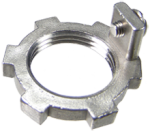I replaced the OLD 100 AMP service with a new 200 AMP service. The original circuit wires to the breaker panel were not long enough to reach the new breaker panel.
So, we installed a j-box. The cirecuit wires run through schedule 80 conduit to the j-box and on to the breaker panel.
The schedule 80 is secured to the j-dox with metal lock nuts.
The nspector said we needed to bond the schedule 80 box.
This would make sence if the j-box was metal, unles the concern is that a wire could come in conact with the metal lock nut.
If so the bonding would be to the lock nut. At least that is how it appears to me.
Any thoughts?
So, we installed a j-box. The cirecuit wires run through schedule 80 conduit to the j-box and on to the breaker panel.
The schedule 80 is secured to the j-dox with metal lock nuts.
The nspector said we needed to bond the schedule 80 box.
This would make sence if the j-box was metal, unles the concern is that a wire could come in conact with the metal lock nut.
If so the bonding would be to the lock nut. At least that is how it appears to me.
Any thoughts?



